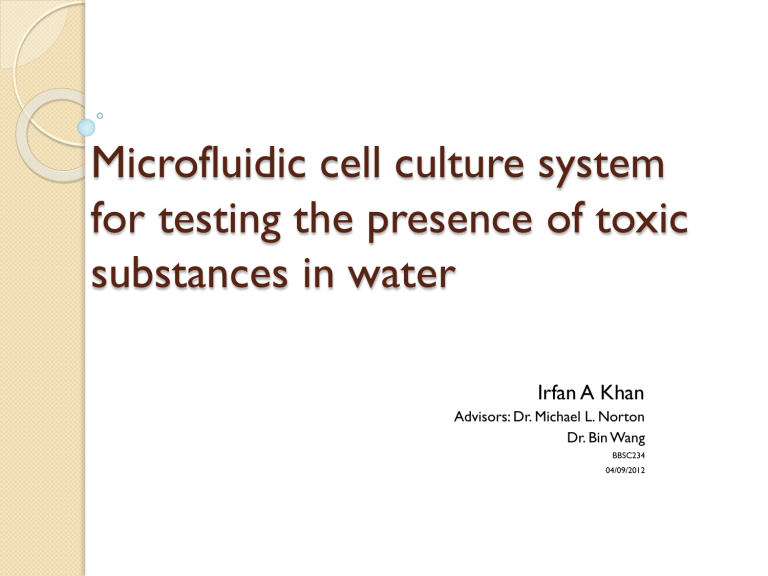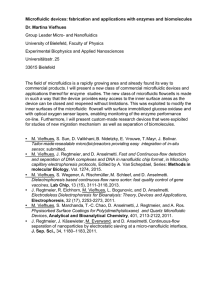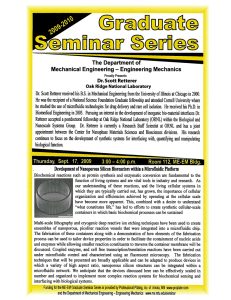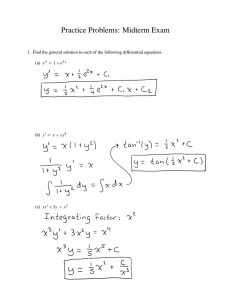
Microfluidic cell culture system for testing the presence of toxic substances in water Irfan A Khan Advisors: Dr. Michael L. Norton Dr. Bin Wang BBSC234 04/09/2012 Background Arsenic contamination in Bangladesh 31 million pounds of toxic chemicals were dumped into the Ohio River in 2007 (Source: Ohio River Foundation) Dioxin, PCB, Metals and Pesticides (Source: EPA) Diagram courtesy: http://cnx.org Introduction Common hazardous environmental toxins ◦ Heavy metals e.g., Pb, Cd, Hg, As ◦ Pesticides and herbicides ◦ Poly-chlorinated biphenyls (PCB) May remain in environment in undetectable concentrations for indefinite period Can reach toxic level inside animal body through biomagnification and bioaccumulation Why endothelial cell culture? Nitric oxide production can be stimulated in healthy cells in vitro Endothelial cells are very sensitive to low levels of toxins Decreases nitric oxide production if exposed to toxic substances SEM Cross-section of an arteriole Image courtesy: http://db2.photoresearchers.com/preview/SB9558.html Endothelial cells Objectives Short term objective: To analyze effect of environmental toxins on nitric oxide production in endothelial cells Long term objective: To test the effect of environmental toxins on endothelial nitric oxide production in cells grown inside a microfluidic chip Hypothesis Endothelial cell culture can be used to develop a very sensitive water toxicity testing method Materials and methods Human umbilical vein endothelial cell (HUVEC) culture Bradykinin (100µM final concentration) Cadmium chloride (40 nM final concentration) Confocal Microscope DAF-FM DA probe for nitric oxide detection The nitric oxide probe DAF-FM DA Cell membrane Esterase DAF-FM DA (No fluorescence) DAF-FM (Weekly fluorescent) NO• Benzotriazole derivative (Fluorescent) Results 30 minutes time course for 1. Cells exposed to bradykinin stimulation only 2. Cells incubated with 40nM CdCl2 for 5 hours prior to bradykinin stimulation 30 min time course for effect of BK on cells without cadmium exposure 30 min time course BK stimulation in cells not exposed to cadmium mean intensity 50 40 30 20 10 0 0 5 10 15 20 Time (minutes) 25 30 The fluorescence intensity does not decrease with time 30 min time course for effect of BK on cells with cadmium exposure 30 min time course BK stimulation in cells exposed to cadmium mean intensity 50 40 30 20 10 0 0 5 10 15 20 Time (minutes) Fluorescence intensity decreases with time 25 30 Conclusion Endothelial cell culture can be used for testing the presence of 40nM cadmium chloride in water by confocal microscopy Future works Testing other environmental toxins Endothelial cells inside microfluidic channels Testing same toxins with microfluidic endothelial cell culture Electrochemical probe will be adopted if possible Acknowledgement Dr. Bin Wang David Neff Dr. Elmer Price Colton Koontz Dr. Michael Norton Dr. Masudur Rahman Thank you Questions please Confocal imaging Single focal plane 30 minutes time course 488nm laser excitation 515-555nm PMT emission window ImageJ for image data analysis MSExcel for plots Confocal scanning microscopy LASER Path of scan (Red line) Focal planes Microfluidic endothelial cell culture Endothelial cells experience 5dyne/cm2 shear stress due to friction with blood flow Increases nitric oxide production with increasing blood flow The shear stress can be mimicked inside a microfluidic chip Endothelial cells lining the arterial wall http://db2.photoresearchers.com/preview/SB9558.html Fig: SEM Cross-section of an arteriole Microfluidic chips The chips are designed by AutoCAD COMSOL Multiphysics is used to simulate proposed designs The chips that give uniform fluid flow in simulation and are easy to operate, are fabricated in PDMS (Poly-dimethyl siloxane) on glass slide PDMS chips on glass slide PDMS is a Crystal clear rubber like material with high tensile strength 5mm For eNOS activity monitoring in microfluidic chips by fluorescence microscopy Contro l Test Cell growth area Directions of fluid flow through the chip Culture maintenance Cell seeding Toxicity testing For eNOS activity monitoring in microfluidic chips by fluorescence microscopy Control Media Test Cell growth area Directions of fluid flow through the chip Culture maintenance Cell seeding Toxicity testing Media Cell growth area For real-time monitoring of effect of substances on endothelial cells inside a microfluidic chip Testing the DAF-FM DA probe Incubated cells for 30 minutes with 5µM DAF-FM DA in dark, at 37⁰C & 5% CO2 Excitation filter of 465-495nm Emission wavelength 505nm – 555 nm No cadmium with BK time course raw data With cadmium with BK time course raw data Arsenic in groundwater: A threat to sustainable agriculture in South and South-east Asia Hugh Brammera, Peter Ravenscroftb a Former FAO Agricultural Development Adviser, Bangladesh, 1974-87. 37 Kingsway Court, Hove, East Sussex, BN3 2LP, United Kingdom b Principal Consultant, Entec UK Ltd, Trinity House, Cambridge Business Park, Cowley Road, Cambridge, CB4 0WZ, United Kingdom Received 20 June 2008. Accepted 15 October 2008. Available online 24 December 2008. http://dx.doi.org/10.1016/j.bbr.2011.03.031



